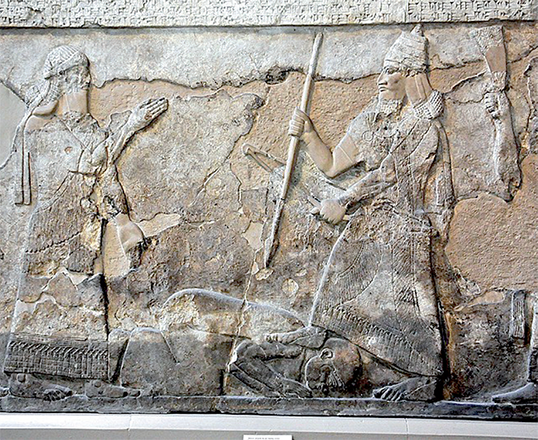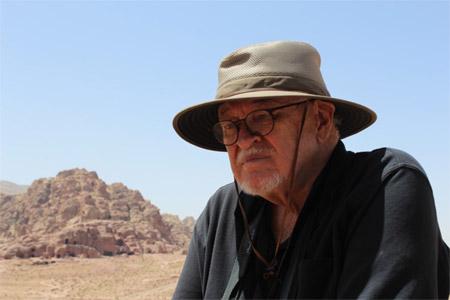You are here
Genesis of Arab history: Look back at 9th century BC
By Saeb Rawashdeh - Feb 23,2024 - Last updated at Feb 23,2024

In this alabaster bas-relief, the Assyrian King Tiglath-Pileser III( right) stands over an enemy’s right shoulder (Photo courtesy of the British Museum)
AMMAN — The recorded history of Arabs began in the 9th century BC with the first attestation of the Old Arabic language. The period of the Neo-Assyrian Empire was very turbulent in the region and Tiglath-Pileser III’s (ruled between 745 BC and 727 BC) launched a campaign against Philistia in 734 BC.
Tiglath-Pileser III finished a period of political and military stagnation of the Assyrian state and expanded his realm westward.
The campaign forced King Hanunu to flee from Gaza to Egypt but he returned soon and was reinstalled as a ruler who would pay an annual tribute to the Assyrian Empire.
“In the process, the city of Gaza was transformed into an Assyrian emporium, apparently to control the commerce between the Levant and Egypt and increase the imperial revenues.
“It is also clear that the other port cities of Philistia were subject to the new Assyrian policy,” noted David Graf.
In the 8th century BC, the land trade routes, as well as Mediterranean ports, were put under Assyrian control and the presence of Arabs was mentioned in the so-called “Display” or “Summary” inscriptions from Nimrud, where tribute of gold, silver, camels and “all kinds of spices” is received from the Arabs, specifically the Arab tribes of Massa, Tema, Saba, Hayappa, Badanu, Hatte, and Idiba’ilu, “who dwell on the border of the western lands”( southern Levant).
Of these, Idiba’ilu was appointed as the “Gatekeeper” facing Egypt, said Graf, adding that although these Arab tribute-bearers follow the episode of Samsi Queen of the Qedarite Arabs, it should be stressed that they are unrelated to this account.
The Summary texts are arranged geographically and not chronologically, some as mere drafts on clay tablets prepared for permanent stone slabs used for display.
The line drawn between Samsi and the Arab tribute bearers on the clay tablets was demarcated as separate episodes involving Arabs.
Furthermore, there is no evidence that Tiglath-Pileser’s campaign extended into the Arabian Peninsula, “so it may be assumed these Arabs were parts of a multi-ethnic commercial community residing at Gaza, where their agents facilitated the long-distant trade at the port city of Gaza”, Graf said.
The Arabs from the Arabian Peninsula, including the distant Sabaeans, were now tributaries under Assyrian imperial administration and after a decade, Philistia again erupted in opposition to Assyrian imperialism, joining a vast Syro-Palestinian coalition that included Egyptian support.
“As a result, the Assyrian king Sargon II in 720 BC began a campaign against the rebel states, defeating first the Syrian tributaries at Qarqar, and then heading south to subject Philistia.
“The king of Gaza, Hanun, supported by Egypt, was defeated at a battle near Raphia, captured and led to Assyria in chains,” Graf underlined.
Sargon followed the path of Tiglath-Pileser II and opened a “sealed harbour” and it contributed to the interaction between Egyptians and Assyrians.
In addition, it has been suggested that Sargon led a campaign between 720 BC and 713 BC into the Beersheba Valley, destroying several sites along the main east-west artery between Gaza and the Arabah, ostensibly to control the Arabian incense route.
“The Egyptian frontier in North Sinai was entrusted to a series of Arab chiefdoms, first by Tiglath-Pileser III, and then by his successors.”
“The area was also resettled by a deported population, probably from Iran, after the Median campaign of 716 BC,” Graf highlighted, noting that in 716 AD Sargon defeated the ‘distant’ Arabian tribes of Tamud, Ibadi, Marsiman and Haiapa and then deported the survivors to Samaria.
These Arab groups appear to be from the north Sinai and northwest Arabia, but no Neo-Assyrian campaign into the Arabian Peninsula is ever recorded.
“This suggests these Arabs were present in the ports of the north Sinai and resisted the invading Assyrian army.”
“In the Assyrian account, they are identified as the Arabs who were ‘overwhelmed’ when Sargon opened up the ‘sealed harbour’ during his campaign of 716 BC,” Graf underscored.
Related Articles
AMMAN — The site of Jamaan is located in the Zarqa Governorate, approximately 16 kilometres north of Amman.
AMMAN — Amman and its surroundings were a main centre of the Ammonite Kingdom and some of their structures can be found on the Amman Citadel
AMMAN — The Nabataean civilisation, most famous for building the rose-red city of Petra, has been the focus of much of the work of a US acad



















